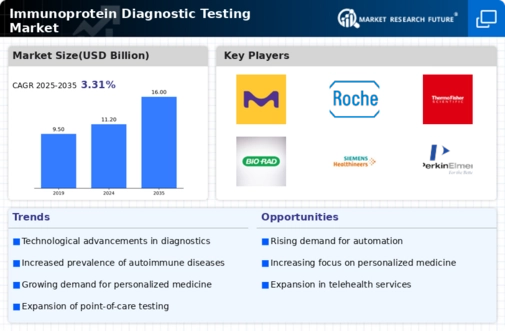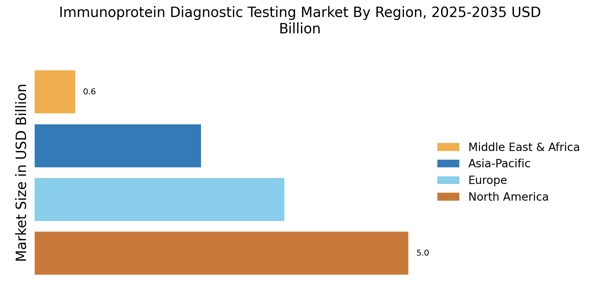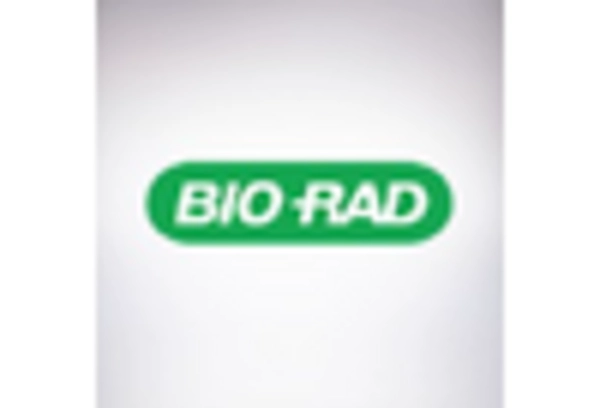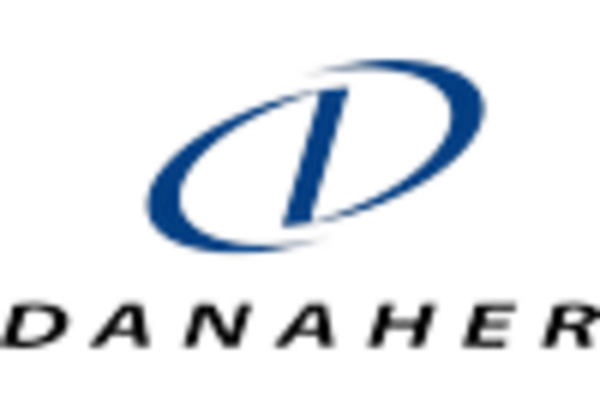Rising Prevalence of Chronic Diseases
The increasing incidence of chronic diseases such as diabetes, cardiovascular disorders, and autoimmune conditions is a primary driver for the Immunoprotein Diagnostic Testing Market. As these diseases often require ongoing monitoring and management, the demand for accurate diagnostic tests is surging. According to recent data, chronic diseases account for approximately 70% of all deaths worldwide, highlighting the urgent need for effective diagnostic solutions. This trend is likely to propel the growth of the immunoprotein diagnostic testing sector, as healthcare providers seek reliable methods to diagnose and monitor these conditions. Furthermore, advancements in immunoprotein assays are expected to enhance the accuracy and efficiency of disease detection, thereby fostering market expansion.
Regulatory Support and Standardization
Regulatory support and standardization initiatives are pivotal in shaping the Immunoprotein Diagnostic Testing Market. Governments and health organizations are increasingly recognizing the importance of reliable diagnostic tests in improving public health outcomes. As a result, there is a concerted effort to establish guidelines and standards for immunoprotein testing, ensuring consistency and accuracy across laboratories. This regulatory framework not only enhances the credibility of diagnostic tests but also fosters innovation within the industry. With clear guidelines in place, manufacturers are more likely to invest in research and development, leading to the introduction of novel immunoprotein assays. Consequently, the establishment of robust regulatory support is anticipated to drive market growth by instilling confidence among healthcare providers and patients alike.
Growing Demand for Personalized Medicine
The shift towards personalized medicine is reshaping the Immunoprotein Diagnostic Testing Market. As healthcare moves away from a one-size-fits-all approach, there is an increasing emphasis on tailored treatment plans based on individual patient profiles. Immunoprotein tests play a crucial role in this paradigm by providing essential information regarding a patient's immune response and disease susceptibility. The market for personalized medicine is projected to reach substantial figures in the coming years, with immunoprotein diagnostics being integral to this growth. By enabling healthcare providers to make informed decisions about treatment options, these tests enhance patient outcomes and satisfaction. Consequently, the demand for immunoprotein diagnostic testing is likely to rise as more healthcare systems adopt personalized approaches to patient care.
Increased Focus on Preventive Healthcare
The growing emphasis on preventive healthcare is a significant driver for the Immunoprotein Diagnostic Testing Market. As healthcare systems worldwide prioritize early detection and prevention of diseases, the role of diagnostic testing becomes increasingly vital. Immunoprotein tests are instrumental in identifying potential health issues before they escalate, allowing for timely interventions. This proactive approach not only improves patient outcomes but also reduces healthcare costs associated with late-stage disease management. Recent studies indicate that investments in preventive healthcare can yield substantial savings, further encouraging healthcare providers to adopt immunoprotein diagnostic testing as a standard practice. As awareness of preventive health measures continues to rise, the demand for these diagnostic tests is expected to grow, thereby bolstering the market.
Technological Innovations in Diagnostic Tools
Technological advancements in diagnostic tools are significantly influencing the Immunoprotein Diagnostic Testing Market. Innovations such as high-throughput screening, microfluidics, and point-of-care testing are enhancing the capabilities of immunoprotein assays. These technologies not only improve the speed and accuracy of tests but also reduce costs, making them more accessible to healthcare facilities. For instance, the introduction of automated platforms has streamlined the testing process, allowing for higher sample throughput and reduced human error. As a result, the market is witnessing a shift towards more sophisticated diagnostic solutions that can cater to the growing demand for rapid and reliable testing. This trend is expected to continue, further driving the adoption of immunoprotein diagnostic tests across various healthcare settings.


















Leave a Comment